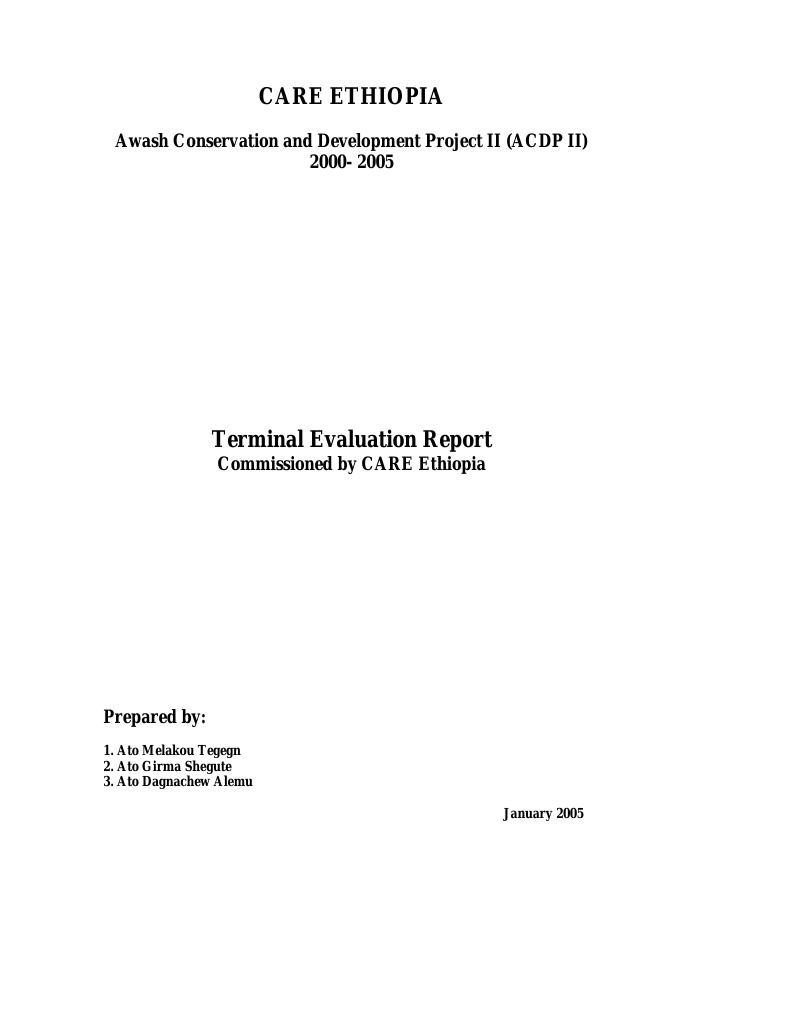Evaluering
Terminal Evaluation of Awash Conservation and Development Project II (ACDP II) 2000-2005
Background Further to local partners: Relevant government offices at local and district levels, such as the Offices for Pastoralists, Women Affairs, Food Security and Water in addition to the administration of Awash National Park. The Awash National Park (ANP) was established in 1969. It is located in the eastern lowlands of Ethiopia, within the rift valley and covers an approximate area of 752 square kilometers. The pastoralist communities of Afar, Ittu and Karayu inhabit the area and live off the natural resources found within and around the Park. Since 1969 there has been a conflict of interests between the park's administration and the local communities on natural resource conservation and management, and the conflict has been further exacerbated by increasing population pressure, drought and ethnic tensions. The effect of human- and livestock population pressure can also be observed as the park's area is shrinking and wildlife resources are diminishing. In 1995, CARE Ethiopia introduced the Awash Conservation and Development Project, aimed at creating a management environment conducive to natural resource conservation and the livelihood security of pastoralists. The objective of the project was to enhance the livelihood security of the Karayu, Ittu and Afar communities; strengthening the conservation capacity of ANP and improving the relations between these communities and the ANP. The ACDP phase II project (2000-2005) was designed to build on the successes of phase I (1995-1999) and to use the lessons learned to achieve a more balanced, integrated and effective conservation- and development practice. The sub-objectives of the second phase were:• Improve the livestock productivity through improved access to water, animal health facilities and animal feed;• Improve community access to basic social services, especially to potable water for domestic use, water & sanitation education and basic education;• Reduce the tensions between the ANP and the communities in and around ANP; The Project was phased out in December 2005. Purpose/objective This evaluation was carried out in order to assess the implementation status of ACDPII with regards to the project's objective, identify major constraints and draw lessons learned and recommendations. Methodology The evaluation methodology was guided by the principle that the views of the project beneficiaries and stakeholders should be clearly captured and reflected. In order to achieve this both a quantitative and qualitative research strategy were developed. A quantitative survey was distributed to 350 randomly sampled households and 13 focus group discussions, in addition to discussions with all the project's stakeholders, were held. Key findings The project's objectives have largely been met: ? Pastoral livestock production was enhanced? Access to veterinary services were improved? The community's access to potable water greatly increased and as such reduced the travel distance in search of water? The participants were enabled to adopt alternative income generating activities through the establishment of saving and loan associations? The focus on supporting women to start income generating activities by the help of saving and loan associations had a positive impact on enhancing the position of women in the pastoral communities in the project area.? A change of attitude towards natural resource conservation were observed within the communities However, there is still a disparity between community needs and project results. This can partly be explained by factors relating to successive droughts that have had a negative impact on the livelihoods of the pastoralists in the area, increasing their need for access to water and livelihood diversification. Furthermore, the ACDP was implemented in an effort to resolve a conflict of interests between natural resource conservation and human livelihood security. The interventions did contribute to a temporary solution to resolve this conflict. However, a single project cannot serve as a sustainable remedy to the root causes of the socio economic conflict between the community and the park, as this needs to be resolved at higher strategic levels. A challenge with regards to the project's objectives was to enhance the collaboration between the community, ANP and local government in the protection of the Awash National Park. This proved to be a difficult area, as the history of the ANP is replete with tensions between the community and the local government. However, the introduction of the innovative Village Conservation and Development Committees (VCDCs) enabled collaboration between the relevant stakeholders in the preservation of the ANP and was a crucial component of the project's achievements. The VCDCs will also be crucial for the sustainability of the project. Recommendations On the basis of the conclusions of the evaluation, some of the recommendations made were: ? There should be a systematic methodology that enables the various stakeholders to fully participate in project design, plan and implementation.? Project interventions in areas characterised by resource scarcity, like these pastoral communities, should to a greater extent focus on the provision of basic needs, such as human and animal water facilities.? A mechanism that sustains the community animal health system and the revolving drug fund should be devised. Comments from the organisation Evaluations are principal instruments in the follow-up of a project, and CARE Norway is devoted to continuous learning and critical assessments of our results. Lessons learned are carried forward and used to inform the design and implementation of new programmes. As this is an evaluation undertaken for CARE Norway, we urge any reader to contact us before applying this information.
